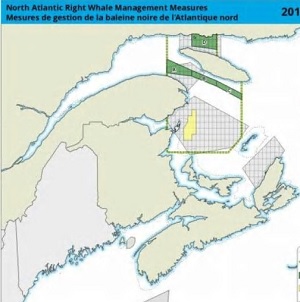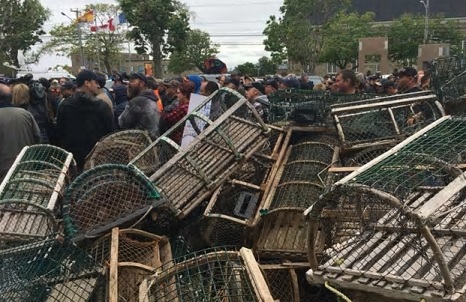Tag Archives: Gulf of St. Lawrence

Seal Fishery Set to Open Tuesday
The seal fishery opens this Tuesday. The fishery will open for longliners, small boats and speed boats on the front and in the Gulf, as well as personal use. DFO has tagged 12 harp seal beaters in the Gulf of St. Lawrence with satellite linked time-depth recorders to track the movement of young seals and determine how they respond to climate change. Harvesters are being asked not to take those tagged seals. The tag is clearly visible and fixed on the animal’s shoulders with an antenna extending over the head. >click to read<15:53

Little Port Harmon fish harvesters hoping for easterly winds
Renny Hickey and Dion Bennett, two fish harvesters out of Little Port Harmon in Stephenville, are wishing for strong easterly winds. That’s because St. George’s Bay is blocked up with the most ice that Hickey says he’s seen there in about 25 years, especially this late. Hickey said he learned Wednesday the crab season is opening this coming Monday and he’s waiting to go but can’t because of the ice in the bay. If the wind from the right direction doesn’t come up before that time, there’s no getting out.Then there’s the lobster season, tentatively set to open on April 18, and he certainly hopes the ice goes out into the Gulf of St. Lawrence before then. >click to read<09:39

FISH-NL: Shrimp quota cut in Gulf of St. Lawrence. Divide between science/fisherman never greater
The Federation of Independent Sea Harvesters of Newfoundland and Labrador (FISH-NL) condemns a 15 per cent cut to the 2019 northern shrimp quota in the Gulf of St. Lawrence for the province’s inshore harvesters. “Our harvesters pushed for an increase — not a cut — but no one’s listening,” says Ryan Cleary, President of FISH-NL. “This is yet another example that the divide between DFO science and fishermen has never been greater.” >click to read<14:36

Striped bass population drops sharply in Gulf of St. Lawrence
The spawning population of striped bass in the Gulf of St. Lawrence plunged in 2018, ending a remarkable run of sustained growth over the past decade, according to a newly released update from Canada’s Department of Fisheries and Oceans. The average estimate is now about 333,000, down from 900,000 in 2017. DFO’s analysis notes its 2018 estimates vary widely from a low of 154,000 spawners to a high of 623,000. So why has the population of striped bass fallen? “Potentially it may be linked to the last few winters. Since 2017, it’s been very rough winters,” said Martin Mallet, a biologist and executive director of the Maritime Fishermen’s Union. >click to read<10:50

Canada: Scientist, fishermen applaud loosening of whale-protection restrictions
The federal government is easing restrictions aimed at protecting North Atlantic right whales based on data from last year, when no whales were found dead in Canadian waters. Fisheries and Oceans Minister Jonathan Wilkinson and Transport Minister Marc Garneau were in Shippagan on Thursday to announce the changes, which include reducing the area that is out of bounds to fishermen.,, Lobster and crab fishing will not be allowed in the static-closure zone, where 90 per cent of North Atlantic right whales in the Gulf of St. Lawrence were sighted last year. >click to read<21:45

25-year-moratorium could be lifted as redfish stocks continue to increase in Gulf of St. Lawrence
Island fishermen and the province are working together to make surGulf of St. Lawrence P.E.I. gets its fair share of the redfish quota if the the federal government decides to reopen the industry in the future. A significant increase in redfish stock in the Gulf of St. Lawrence is spurring an interest in reopening redfish harvesting after a moratorium has been in place for nearly 25 years. A renewed commercial fishery would be at least two years away, said Dave MacEwen, P.E.I.’s manager of marine fisheries. Other provinces will be looking for their share of the quota as well, and he wants to make sure Island fishermen are “full participants.” >click to read<19:51

Early ice growth means busy icebreaking season for coast guard vessels, officials in St. John’s say
The Canadian Coast Guard icebreaker fleet is expecting a busy season with the freeze-up of sea ice occurring three to four weeks ahead of a normal ice year, officials said in St. John’s Tuesday. Brad Durnford, superintendent of ice operations for the Atlantic Region, said during a technical briefing that water temperatures are lower than normal around the Gulf of St. Lawrence and Newfoundland and Labrador, and long-term forecasts show Eastern Canada having a chance of a cooler than normal winter, which will continue the ice growth. >click to read<09:44

N.S. pulp mill due in court to ask for injunction against fishermen’s blockade
Lawyers for the Northern Pulp mill are due in Nova Scotia Supreme Court today to seek an injunction that would prevent fishermen from blocking survey boats hired to examine a route for an effluent pipeline. Kathy Cloutier, a spokeswoman for Northern Pulp’s parent company, Paper Excellence Canada, confirmed the mill is seeking an interim injunction to prevent blockades of the survey work in the Northumberland Strait. A group of fishermen has stated they would block any survey boats from entering the Strait. >click to read<11:30

Nova Scotia looks to keep redfish quota as other provinces want in
A Nova Scotia seafood company is urging the federal government to wait several years before starting a large-scale commercial harvest for redfish in the Gulf of St. Lawrence. Also known as ocean perch, the species has made a remarkable comeback after a 25-year moratorium. “This biomass is huge. It’s probably the largest in history,” said Jan Voutier of Louisbourg Seafoods Ltd., a Nova Scotia redfish harvester and processor. It’s believed 3.5 million tonnes of redfish are in the gulf today, setting the stage for a looming interprovincial conflict in Atlantic Canada over who gets a piece of the action.”All of a sudden, everyone wants to rush in and get the pot of gold, as it were,” said Keith Colwell, Nova Scotia’s fisheries minister. >click to read<12:20

Feds planning 2019 protections for North Atlantic right whales
How the federal government will confirm, modify or adapt protective measures for North Atlantic right whales in 2019 remains to be seen, but officials are sharing the initial findings of 2018’s scientific surveys and studies. After a catastrophic loss of 12 right whales in Canadian waters in 2017, no right whales died here this year, but at a technical briefing Tuesday, officials from Fisheries and Oceans Canada (DFO) and Transport Canada didn’t say whether protections put in place this year were enough — or too much. ,,, Instead they shared key results of a recent peer review of new science by researchers, industry representatives, government officials — as well as scientists from the National Oceanic and Atmospheric Administration in the U.S. — who gathered in Montreal in an effort to reach evidence-based conclusions.>click to read<08:48

Northern Pulp – Senators want full assessment of plan to dump mill effluent off Nova Scotia coast
A group of Independent senators is calling on the Trudeau government to do a full environmental assessment of a “dangerous” plan in Nova Scotia to take effluent from a pulp mill, pipe it 10 kilometres out into the Northumberland Strait, and dump it. In the Red Chamber on Monday, Sen. Mike Duffy called it “a looming environmental crisis in the Gulf of St. Lawrence.”,, Last week, along with Sen. Diane Griffin, a conservationist from P.E.I., they met with representatives of fisheries groups from all three Maritime provinces. “If this scheme is allowed to proceed, it could damage the fishery in the three Maritime provinces, Quebec’s Magdalen Islands, and beyond,” >click to read<18:25

Fisheries minister meets with stakeholders to discuss right whale protections
The federal fisheries minister met with fishermen, industry representatives and marine scientists Tuesday to discuss the impact of restrictions put in place to protect North Atlantic right whales and whether they may be needed for the coming fishing seasons. Jonathan Wilkinson sat down with dozens of stakeholders at a hotel in Dartmouth, N.S., to discuss measures introduced earlier this year that were aimed at shielding the marine mammals against fishing gear entanglements and ship strikes — their greatest threats. >click to read<13:31

Feds review this year’s right-whale protections
It was enough. But was it too much? That’s the question Fisheries and Oceans Canada wants to answer after a season of unprecedented measures to protect North Atlantic right whales — including mandatory ship slowdowns and fisheries closures. To date, none of the critically endangered whales has died in Canadian waters in 2018, unlike in 2017, when 12 died in the Gulf of St. Lawrence, largely due to ship strikes and entanglements in fishing gear.,,, On the East coast, the department (DFO) is now holding regional meetings with members of the fishing industry to gather feedback on those management measures. >click to read<15:03

Measures to protect North Atlantic right whales have been effective, official says
Representatives of the fishing industry and Fisheries and Oceans Canada met in Moncton over the weekend to look at the impact protection measures were having on the North Atlantic right whale — and to help decide what should happen next year. The 2018 fishing season has been controversial, with fishermen in the Acadian Peninsula protesting the new federal measures that were put in place to protect the North Atlantic right whale. Some of those measures included closing several fisheries where whales were present in the Gulf of St. Lawrence, speed restrictions for boats and increased surveillance. >click to read<15:34

Fishermen weathering effects of climate change
The lobster off western Cape Breton didn’t get the memo about thriving in colder water. “They should have told the lobsters that this year,” said John Phillip Rankin, a fisherman from Mabou Coal Mines. “By the first of July, it was warm and they started snapping but we were after putting our traps on the wharf. They start jumping when it gets warmer. They do all right in cold water. It was a decent season but it was cold-water trapping, you could tell. Last year, it was warm right through, a better season. The landings were quite a bit higher.” >click to read<14:35

FISH-NL calls on DFO to take direct control of scientific quota of redfish in the Gulf of St. Lawrence
“The FFAW-Unifor should not be controlling science quotas,” says Boyd Lavers, an inshore harvester from Port Saunders on the Great Northern Peninsula, and Captain of FISH-NL’s over 40-foot fleet. “The only fair way to deal with this experimental quota is for it to be handled directly by DFO, so the FFAW doesn’t get a chance to show favouritism as to who fishes the quota, or to take a cut from the sale of the fish.”,,, Further, harvesters have been told by the union they will have to sell the redfish to a plant of the FFAW’s choosing, and pay the union half the money from the sale of the fish. >click to read<18:35

Bid to reduce right whale deaths ‘extremely effective,’ Canadian officials say
A year after the population of critically endangered North Atlantic right whales suffered devastating losses, Canadian officials say measures taken this season to protect the species have worked. With the summer fishing season in the Gulf of St. Lawrence drawing to a close, the federal Fisheries Department confirmed Friday that not one whale has died as a result of a ship strike or fishing gear entanglement — the main causes for most of the deaths last season. In all, 17 right whales died last year — 12 of them in Canadian waters,,, The federal government responded with a series of protection measures, which included speed restrictions for boats, increased surveillance and a series of closures of fishing areas where right whales were spotted. >click to read<11:36

Scientists and fishermen team up to help save North Atlantic right whale
Whale researchers and fishermen are out at sea together on a two-week mission, combining efforts to help save the endangered north Atlantic right whale. These two worlds have usually stayed far apart, but for the first time scientists are onboard a crab boat to do their field work. Crab fisherman Martin Noel, captain of the Jean-Denis Noel boat in Shippagan, agreed to take scientists out in the gulf to help them carry out their research this year. “We don’t want to be called whale killers,” Noel said. “We want to be called fishermen that are implicated in the solution.” All season, fishermen begged Ottawa to involve them in fisheries management. They felt the federal government was imposing overly strict measures without consultation with industry. >click to read<09:28

DFO closes more fishing zones after right whale sighting
The Department of Fisheries and Oceans has closed portions of four fishery grids after right whales were spotted in the area. The affected grids are in the extreme south of the speed reduction zone and will begin at 10 a.m. on Friday. The closure marks the 20th fishery closure this year related to the North Atlantic right whale. No right whales have been found dead in Canadian waters since last year but a right whale was spotted last week off Miscou Island partially entangled. It has not been spotted since. >click to read<18:33

FISH-NL demands Ottawa explain itself in light of massive cuts to caplin quotas
The Federation of Independent Sea Harvesters of Newfoundland and Labrador (FISH-NL) is demanding Ottawa explain itself in light of huge cuts to caplin quotas in the Gulf of St. Lawrence and off eastern and southern Newfoundland and Labrador. “This is a banner year for caplin in the Gulf with the federal government’s own scientists reporting an abundance of fish not seen in years, and yet the quota has been cut by 35 per cent,” says Ryan Cleary, President of FISH-NL. “How does that make sense? It doesn’t.” “At the same time, scientists said in March that the caplin stock off eastern Newfoundland and Labrador was down 70 per cent, but the relatively small commercial fishery isn’t having an impact,” he added. >click to read<11:57

Bay of Fundy fishery has whale of a problem
I’ve worked for the Grand Manan Fishermen’s Association for 25 years. It’s been a good career; there’s always something new in the fishery. I’ve gotten to know some great people both locally and across the country. I come from a fishing family: my father, brother and brother-in-law are all fishermen. I have a strong attachment to what I do and why I do it.,, The right whales ventured north to the Gulf of St. Lawrence. Things were bad last summer. Twelve whales were found dead. Two were entangled in fishing gear. The rest: blunt force trauma or unknown causes, though none of those had fishing gear on them. Government swung into reactionary precautionary mode. We watched amazed and horrified from the other side of the Maritimes while fishery after fishery closed.
Then last week it was our turn. by Bonnie Morse >click to read<21:25

DFO closes another fishing area in northern N.B. after right whale sighting
Another fishing area in the Gulf of St. Lawrence has been closed by the Department of Fisheries and Oceans after North Atlantic right whales were spotted. The latest closure in extends the no-fish zone farther east, well into the middle of the Gulf. The measures will see the following grid closed: GX39. Fishermen have until Tuesday at 3 p.m. to remove any fishing gear in the area. This is the seventh closure of a fishing area over the last month in the waters off northern New Brunswick that has forced crab fishermen and lobster fishermen to move their fishing gear to other areas. >click to read<11:33

New DFO orders ‘hard pill to swallow’ for N.B. lobster fishermen
Lobster fishermen off the coast of Miscou Island, N.B., will spend Sunday morning hauling gear from the waters in order to comply with the latest fishing zone closures imposed by the Department of Fisheries and Oceans. On Friday afternoon, the DFO re-opened four areas previously closed to fishing due to the presence of right whales. But with more closures being imposed on Sunday, frustrations continue to mount. Carl Allen, president of the Maritime Fishermen’s Union, organized the most recent protest and met with LeBlanc on Friday.,,”I have a lot of respect for Minister LeBlanc, but we just don’t agree with the basis of the whole plan — it’s a hard pill to swallow,” he said.,, LeBlanc did offer the fishermen an alternative, however. He offered a paid training program for crew members and plant workers affected by these closures. >click to read<18:20

Lobster harvesters unfairly blamed of harm to North Atlantic right whales
Much has been written about the ongoing challenge of protecting the North Atlantic right whale along the eastern seaboard of the U.S. and in the Gulf of St. Lawrence. The impact the 18 reported deaths in 2017 has had on the entire right whale population cannot be understated. The issue in many cases has been a lack of substantiated facts with regard to specific fisheries and the ongoing commitment by key fisheries to protect the right whale. The Canadian lobster fishery is one of those key fisheries that has, until now, remained silent about our role and our ongoing commitment to North Atlantic right whale protection. Our harvesters and processors do what’s needed to ensure a sustainable fishery without fanfare. >click to read<08:28

Lobster fishermen create wall of empty traps at protest against closures
Nearly 500 fishermen brought empty lobster traps to Caraquet on Thursday to protest against the closure of fishing areas in the Gulf of St. Lawrence while endangered whales swim there. The protest came after another round of fishing area closures was announced by Ottawa this week because five North American right whales were spotted between Miscou and the Gaspé Peninsula. “We’ve never entangled one in lobster gear in these areas, ever,” said Carl Allen, president of the Maritime Fishermen’s Union, who organized the protest. Allen said the closures not only hurt fishermen and processing plant workers but also local economies on the Acadian Peninsula. >click to read<22:03

Ottawa considers help for Gulf of St. Lawrence fisheries after right whale protection measures
“At the moment we are not talking about compensating with actual financial compensation the fishermen,” LeBlanc said in a telephone interview. New Brunswick Fisheries Minister Rick Doucet called Monday for measures to address lost revenue, and LeBlanc said that is “entirely consistent” with his department’s approach to the developing situation in the Gulf of St. Lawrence. LeBlanc said it includes looking at ways to help processing plant workers qualify for Employment Insurance, and a possible fall opening of the lobster fishery to make up for lost days. >click to read<Meanwhile, Lobster and crab fishermen in Quebec ‘out of options’ as more zones closed off – “I don’t know how we’re going to get out of this one,” said O’Neil Cloutier, the general manager of the professional fishermen’s association of southern Gaspé. >click to read<19:39

Fisheries minister urges Ottawa to help fishermen make up for revenue lost to Gulf closures
New Brunswick’s fisheries minister is calling on Ottawa to find ways to make up for lost revenue in the fishing industry in light of a growing number of closures in the Gulf of St. Lawrence designed to protect North Atlantic right whales. Rick Doucet issued a statement on Monday night after Fisheries and Oceans Canada announced 10 new grids will be temporarily closed, effective June 15 at 4 p.m. AT, due to the presence of whales. The affected areas include: GV32, GV33, GV34, GV35, GX32, GX33, GX34, GW32, GW33 and GW34. Fishermen and fish processors alike are concerned about lost revenue, said Doucet. >click to read<23:39

DFO will not change fishing area closures, despite proposed exemptions
In a statement released Friday, department officials said they had received proposals from the Maritime Fishermen’s Union and from the Regroupement des Pêcheurs professionnels du Sud de la Gaspésie asking the department to consider exempting shallow waters from temporary closures. However, the department has concluded that the measures will remain in place to protect the North Atlantic right whales from gear entanglements. “This course of action is based on the best science information available about the presence of right whales in our waters,” the statements said. >click to read<11:19

Notice of fisheries closures – Fishermen told to remove gear from gulf areas to protect right whales
Fishermen have until Wednesday to get their gear out of the water in five newly closed fishing zones of the Gulf of St. Lawrence. The Department of Fisheries and Oceans has gotten reports of North Atlantic Right Whales in the area prompting the closure of more fishing zones. DFO said crews must remove their gear by 5 p.m. AT on Wednesday, June 6. The next 24 hours will bring high winds, so DFO is allowing a longer notice than usual. “All gear must be removed from the closed area before the time of closure,”>click to read<DFO notice>click here<08:04















































